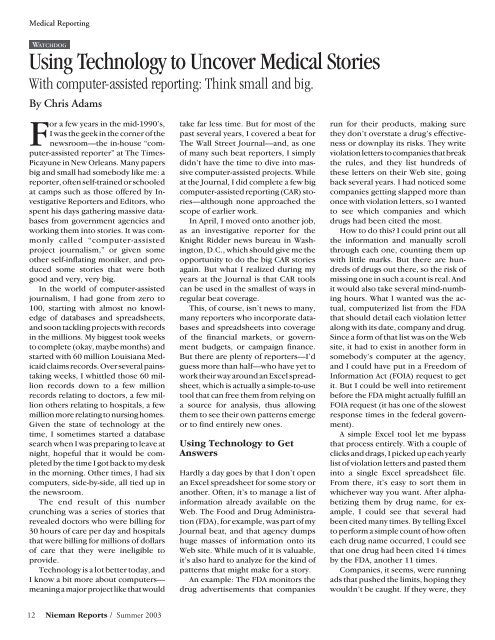summer-2003-Part 2-live - Nieman Foundation - Harvard University
summer-2003-Part 2-live - Nieman Foundation - Harvard University
summer-2003-Part 2-live - Nieman Foundation - Harvard University
- No tags were found...
Create successful ePaper yourself
Turn your PDF publications into a flip-book with our unique Google optimized e-Paper software.
Medical ReportingWATCHDOGUsing Technology to Uncover Medical StoriesWith computer-assisted reporting: Think small and big.By Chris AdamsFor a few years in the mid-1990’s,I was the geek in the corner of thenewsroom—the in-house “computer-assistedreporter” at The Times-Picayune in New Orleans. Many papersbig and small had somebody like me: areporter, often self-trained or schooledat camps such as those offered by InvestigativeReporters and Editors, whospent his days gathering massive databasesfrom government agencies andworking them into stories. It was commonlycalled “computer-assistedproject journalism,” or given someother self-inflating moniker, and producedsome stories that were bothgood and very, very big.In the world of computer-assistedjournalism, I had gone from zero to100, starting with almost no knowledgeof databases and spreadsheets,and soon tackling projects with recordsin the millions. My biggest took weeksto complete (okay, maybe months) andstarted with 60 million Louisiana Medicaidclaims records. Over several painstakingweeks, I whittled those 60 millionrecords down to a few millionrecords relating to doctors, a few millionothers relating to hospitals, a fewmillion more relating to nursing homes.Given the state of technology at thetime, I sometimes started a databasesearch when I was preparing to leave atnight, hopeful that it would be completedby the time I got back to my deskin the morning. Other times, I had sixcomputers, side-by-side, all tied up inthe newsroom.The end result of this numbercrunching was a series of stories thatrevealed doctors who were billing for30 hours of care per day and hospitalsthat were billing for millions of dollarsof care that they were ineligible toprovide.Technology is a lot better today, andI know a bit more about computers—meaning a major project like that wouldtake far less time. But for most of thepast several years, I covered a beat forThe Wall Street Journal—and, as oneof many such beat reporters, I simplydidn’t have the time to dive into massivecomputer-assisted projects. Whileat the Journal, I did complete a few bigcomputer-assisted reporting (CAR) stories—althoughnone approached thescope of earlier work.In April, I moved onto another job,as an investigative reporter for theKnight Ridder news bureau in Washington,D.C., which should give me theopportunity to do the big CAR storiesagain. But what I realized during myyears at the Journal is that CAR toolscan be used in the smallest of ways inregular beat coverage.This, of course, isn’t news to many,many reporters who incorporate databasesand spreadsheets into coverageof the financial markets, or governmentbudgets, or campaign finance.But there are plenty of reporters—I’dguess more than half—who have yet towork their way around an Excel spreadsheet,which is actually a simple-to-usetool that can free them from relying ona source for analysis, thus allowingthem to see their own patterns emergeor to find entirely new ones.Using Technology to GetAnswersHardly a day goes by that I don’t openan Excel spreadsheet for some story oranother. Often, it’s to manage a list ofinformation already available on theWeb. The Food and Drug Administration(FDA), for example, was part of myJournal beat, and that agency dumpshuge masses of information onto itsWeb site. While much of it is valuable,it’s also hard to analyze for the kind ofpatterns that might make for a story.An example: The FDA monitors thedrug advertisements that companiesrun for their products, making surethey don’t overstate a drug’s effectivenessor downplay its risks. They writeviolation letters to companies that breakthe rules, and they list hundreds ofthese letters on their Web site, goingback several years. I had noticed somecompanies getting slapped more thanonce with violation letters, so I wantedto see which companies and whichdrugs had been cited the most.How to do this? I could print out allthe information and manually scrollthrough each one, counting them upwith little marks. But there are hundredsof drugs out there, so the risk ofmissing one in such a count is real. Andit would also take several mind-numbinghours. What I wanted was the actual,computerized list from the FDAthat should detail each violation letteralong with its date, company and drug.Since a form of that list was on the Website, it had to exist in another form insomebody’s computer at the agency,and I could have put in a Freedom ofInformation Act (FOIA) request to getit. But I could be well into retirementbefore the FDA might actually fulfill anFOIA request (it has one of the slowestresponse times in the federal government).A simple Excel tool let me bypassthat process entirely. With a couple ofclicks and drags, I picked up each yearlylist of violation letters and pasted theminto a single Excel spreadsheet file.From there, it’s easy to sort them inwhichever way you want. After alphabetizingthem by drug name, for example,I could see that several hadbeen cited many times. By telling Excelto perform a simple count of how ofteneach drug name occurred, I could seethat one drug had been cited 14 timesby the FDA, another 11 times.Companies, it seems, were runningads that pushed the limits, hoping theywouldn’t be caught. If they were, they12 <strong>Nieman</strong> Reports / Summer <strong>2003</strong>
















